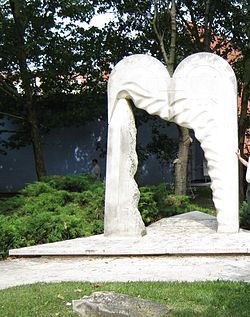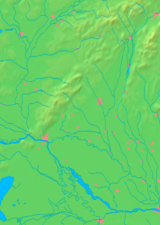- Dunajská Streda
-
Dunajská Streda Dunaszerdahely Town Country Slovakia Region Trnava District Dunajská Streda Tourism region Podunajsko Elevation 118 m (387 ft) Coordinates 47°59′40″N 17°37′10″E / 47.99444°N 17.61944°E Area 31.451 km2 (12 sq mi) Population 23,467 (2006-12-31) Density 746 / km2 (1,932 / sq mi) First mentioned 1250 Mayor Zoltán Hájos Timezone CET (UTC+1) - summer (DST) CEST (UTC+2) Postal code 929 01 Phone prefix 421-31 Car plate DS Wikimedia Commons: Dunajská Streda Statistics: MOŠ/MIS Website: http://www.dunstreda.eu/ Dunajská Streda (Slovak: Dunajská Streda,
 pronunciation (help·info); Hungarian: Dunaszerdahely; German: Niedermarkt) is a town in southern Slovakia (Trnavský kraj). Dunajská Streda is the most important town of the Žitný ostrov region. It has a Hungarian ethnic majority and its population is 23,562 (2004 census)
pronunciation (help·info); Hungarian: Dunaszerdahely; German: Niedermarkt) is a town in southern Slovakia (Trnavský kraj). Dunajská Streda is the most important town of the Žitný ostrov region. It has a Hungarian ethnic majority and its population is 23,562 (2004 census)Contents
Name
The name of Zerda was first mentioned in 1250 in a document issued by Palatinus Lórant. Other early orthographic forms of the name were Svridahel (1254), Zeredahely (1270), Zerdahel (1283) and Zredahel (1358). Szerdahely means "Wednesday (market)place" in Hungarian and it indicates the town had the privilege to hold a market on Wednesdays (although it was later changed to Fridays). The word szerda itself has Slavic roots, the word streda means Wednesday in slavic languages as it is the middle (stred) day in the week. The attribute Duna- (Dunajská; i.e. Danubian) was added in the 19th century. The modern Slovak name means the same as the Hungarian (streda means Wednesday in Slovak). The German name Niedermarkt means "Lower Market".
History
According to archeological evidence the territory was inhabited in the Neolithic, Bronze, Roman and Great Moravian period. The region was part of the arising Hungarian state since the late 10th century.
In the Middle and Modern Ages the settlement was a little market town in the southern part of Pozsony county and a commercial and administrative centre for the neighbouring villages. After 1808, after 1863, and in 1960 it was amalgamated with several smaller settlements.
The population of the town has been predominantly Hungarian at least since the late Middle Ages. The first detailed description of the territory of the town is a charter of King Charles I of Hungary from 1341 when the king gave the estate of Pókafölde to comes Tamás. In the middle of the 15th century Szerdahely became an oppidum, or market town. The first conscription of the population happened in 1574 (26 royal serf families and 3 noble families). The next conscription in 1646 indicates that most citizen were craftsmen. The town was under the feudal jurisdiction of the Pálffy family between 1600 and 1848. Many Jews came in the 18th century. In 1880 the town had 4182 inhabitants out of which were 3,531 Hungarian and 416 German by mother tongue. The number of the Jewish population was 1,874. In 1910 there were 4,679 Hungarian by mother tongue from a total 4,762. In 1930, the town had 5,706 inhabitants, including 2,944 Hungarians, 2,186 Jews (mostly Hungarian-speaking) and 503 Slovaks. According to the 2001 census, 18,756 Hungarians, 3,588 Slovaks, 353 Roma people, 147 Czechs and 24 Germans live in the city, meaning a Hungarian majority of over 80%, one of the highest proportions of any municipality in the country.
In 1919 it became part of Czechoslovakia. It became part of Hungary again in the First Vienna Award in 1938, but was returned to Czechoslovakia in 1945 after World War II. In 1947-48, Czechoslovakia forced a part of the town's Hungarian population to emigrate to Hungary as a part of the forced population transfer carried out in the frameweork of the so-called Hungarian-Czechoslovakian population exchange.
During the communist era the town underwent rapid modernization and industrialization. Almost all of the old houses of the centre and 85% of the town-apartments were replaced with new ones. In the 1990s the centre of the town was totally rebuilt and revitalized according to the plans of Imre Makovecz, a Hungarian architect of the "Organic" school. Today, it is one of the centres of the Hungarian national community in Slovakia and is the fastest growing city of southern Slovakia.
Sights
- The Roman Catholic Church of Our Lady was founded in 1341 and rebuilt in the Gothic style in 1541. It was rebuilt again in Baroque style in the end of the 18th century. In front of the church there is a memorial for the Hungarian Revolution in 1848-49.
- The Evangelical Church was built in 1883 in Romanesque Revival style. There is a new Reformed Church (1996) next door.
- The Jewish Synagogue was destroyed by a bomb in 1945, and the ruins were knocked down in 1955. There is a Holocaust Memorial (1991) on the lot today.
- The Yellow Castle was built by the landowning Kondé family in 1770 and was rebuilt in the Neoclassical style in the 19th century. Today it is the home of the Csallóköz Museum.
- Postmodern town hall and commercial centre by Imre Makovecz.
Coat-of-arms
The 19th century seal of the market town depicted St Peter with the inscription "Sigillum Oppidi Szerdahely". According to the tradition the old coat-of-arms of the town depicted this figure in blue clothes, in a green field, on a silver shield, but it is disputed whether it was a real coat-of-arms or only a seal symbol. In 1910 the town applied to the State Municipality Registration Committee for a new seal without any picture (inscription: "Pozsony vármegye Dunaszerdahely község 1910"). After that the St Peter figure was finally dropped from the municipal symbols.
The modern symbol of town is a talking coat-of-arms: "a split shield with the right field five times divided by blue and gold and with the left red field with the gold sign of Wednesday (Mercurius’ symbol)." The six stripes on the right symbolize the six villages amalgamated in the course of history to compose the modern town. The blue and gold colours refer to the river Danube and the large wheatfields of the region. The antique Mercurius/Wednesday symbol refer to the old Wednesday markets which gave the name of the town.
Demographics (2001 census)
 The Jewish Holocaust memorial in the center of the town. Before the Holocaust about half of the town's population was Jewish. The memorial is shaped as a torn out Tablets of Stone, and was erected where the main town's synagogue was located.
The Jewish Holocaust memorial in the center of the town. Before the Holocaust about half of the town's population was Jewish. The memorial is shaped as a torn out Tablets of Stone, and was erected where the main town's synagogue was located.
According to the 2001 census, from 23,519 inhabitants there were 79.75% Hungarians, 15.26% Slovaks, 1.50% Roma and 0.63% Czechs. The religious make-up was 72.91% Roman Catholics, 11.11% with no religious affiliation, 2.04% Lutherans and others.[1]
In 1910, 50.2% of the population was Roman Catholic, 43.6% Jewish and 3.5% Calvinist.
Education
There are Slovak and Hungarian language secondary schools in the town, called Gymnázium s vyučovacím jazykom slovenským and Vámbéry Ármin Magyar Tanítási Nyelvű Gimnázium.
Recent events
A 2008 soccer match between FC Dunajska Streda and Slovan Bratislava was disrupted by Slovak riot police after only 15 minutes injuring more than 60 people, many of whom lost consciousness or suffered injuries including concussion and broken jaws.[2] Local policemen stormed Hungarian nationals, who were at the game to support the home team and to protest the burning of a Hungarian flag at an earlier game.[2] flags with Árpád stripes, favoured by the extreme right in Hungary, were being waved and the home crowd sang the Hungarian national anthem before kickoff.[2]
Press reports from the scene said that the police failed to act against Bratislava supporters who were throwing smoke bombs, noise grenades and other missiles on the pitch.[2] Based on videos posted on the internet showing the incident from various angles the supporters were not doing anything that would warrant such an intervention by police.[2] Five days after the game the Slovak police presented a photo as evidence, showing one of the supporters raising his fist to throw a punch, but police officers can not be seen on the image.[2] Spontaneous demonstrations were held in Budapest at the embassy and the consulate of Slovakia on the night of the incident.[2] Protesters lit candles to honor the victims and burned a Slovak flag.[2]
Famous people
- Ármin Vámbéry, orientalist
- Jan Durica, footballer
- István Sarlay (1894–1962), Lieutenant Colonel, First World War hero /battles in Bosnia-Hercegovina/, awarded by Signum Laudis with swords /Military Merit Medal (Austria-Hungary)/, Silver Medal of Bravery 1st Class, Silver Medal of Bravery 2nd Class, Bronze Medal of Bravery, Karl-Cross, Wound Medal (Austria-Hungary) /2x wounded/ etc.
- Herman Steiner (1905–1955), United States Chess Champion, 1948–1950
- Dajana Filistovova (1984–Present) European Mixed Table Tennis Championship Winner 2001 and 3 time bronze medalist.
Twin cities
References
- ^ Mestská a obecná štatistika SR
- ^ a b c d e f g h Leitner, Attila (2008-11-10). "Hungarians attacked". The Budapest Times. http://www.budapesttimes.hu/content/view/9883/213/. Retrieved 2009-05-17.
External links
- Municipal website
- FC DAC 1904, Football club of Dunajská Streda
- [1], Dunajská Streda Town Hall official website
Dunajská Streda • Šamorín • Veľký Meder
Báč • Baka • Baloň • Bellova Ves • Blahová • Blatná na Ostrove • Bodíky • Boheľov • Čakany • Čenkovce • Čiližská Radvaň • Dobrohošť • Dolný Bar • Dolný Štál • Dunajský Klátov • Gabčíkovo • Holice • Horná Potôň • Horné Mýto • Horný Bar • Hubice • Hviezdoslavov • Jahodná • Janíky • Jurová • Kľúčovec • Kostolné Kračany • Kráľovičove Kračany • Kútniky • Kvetoslavov • Kyselica • Lehnice • Lúč na Ostrove • Macov • Mad • Malé Dvorníky • Medveďov • Michal na Ostrove • Mierovo • Nový Život • Ňárad • Ohrady • Okoč • Oľdza • Orechová Potôň • Padáň • Pataš • Povoda • Rohovce • Sap • Štvrtok na Ostrove • Topoľníky • Trhová Hradská • Trnávka • Trstená na Ostrove • Veľká Paka • Veľké Blahovo • Veľké Dvorníky • Vieska • Vojka nad Dunajom • Vrakúň • Vydrany • Zlaté Klasy Categories:
Categories:- Dunajská Streda
- Cities and towns in Slovakia
- Villages and municipalities in Dunajská Streda District
- Historic Jewish communities
Wikimedia Foundation. 2010.







